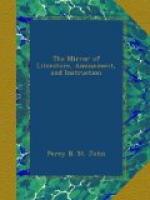[15] Mr. Chambers describes Sir
Walter’s eyebrows as so shaggy
and prominent, that, when he was reading
or writing at a
table, they completely shrouded the
eyes beneath; and
the Ettrick Shepherd speaks of Sir Walter’s
shaggy
eyebrows dipping deep over his eyes.
[16] One of the amusements of Sir
Walter’s retirement was to
walk out frequently among his plantations
at Abbotsford,
with a small hatchet and hand-saw, with which
he lopped
off superfluous boughs, or removed an entire
tree when it
was marring the growth of others. The
author of
Anastasius delighted in a similar
pursuit; he would
stroll for hours through the winding walks
of the
Deepdene plantation, and with a small hatchet
or shears
lop off the luxuriant twigs or branches that
might spoil
the trim neatness of the path.
Among the accredited portraits of Sir Walter Scott is that painted by the late Sir Henry Raeburn, which has been engraved in a handsome style; another portrait, by Mr. Leslie, was engraved in the Souvenir, a year or two since, and was styled in the Noctes of Blackwood’s Magazine, “the vera man himsel;” but the latest, and perhaps the best, was painted not many month’s since, by Mr. Watson Gordon, and admirably engraved by Horsburgh, of Edinburgh, for the revised edition of the Novels. A whole-length portrait of the Poet in his Study, at Abbotsford, was painted a few years since, in masterly style, by Allan, and engraved by Goodall for the Anniversary, edited by Mr. Cunningham, who informs us that “a painting is in progress from the same hand, showing Sir Walter as he lately appeared—lying on a couch in his principal room: all the windows are closed save one, admitting a strong central light, and showing all that the room contains—in deep shadow, or in strong sunshine.” A splendid portrait of the Poet was painted by Sir Thomas Lawrence for the late King, and exhibited at the Royal Academy a few years since; an engraving of which has been announced by Messrs. Moon, Boys, and Graves, his present Majesty having graciously granted the loan of the picture for this purpose.[17]




